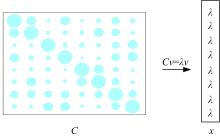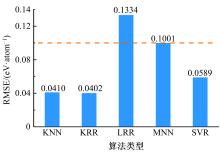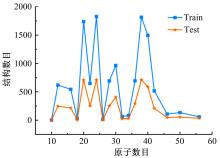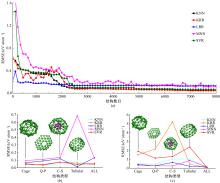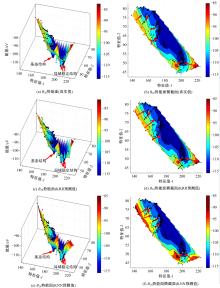吉林大学学报(工学版) ›› 2021, Vol. 51 ›› Issue (2): 667-676.doi: 10.13229/j.cnki.jdxbgxb20191070
• 计算机科学与技术 • 上一篇
机器学习加速CALYPSO结构预测的可行性
- 1.吉林大学 计算机科学与技术学院,长春 130012
2.吉林大学 超硬材料国家重点实验室,长春 130012
Accelerating CALYPSO structure prediction with machine learning
Xiao-hui WEI1( ),Chang-bao ZHOU1,Xiao-xian SHEN1,Yuan-yuan LIU1,Qun-chao TONG2
),Chang-bao ZHOU1,Xiao-xian SHEN1,Yuan-yuan LIU1,Qun-chao TONG2
- 1.College of Computer Science & Technology,Jilin University,Changchun 130012,China
2.State Key Lab of Superhard Materials,Jilin University,Changchun 130012,China
摘要:
对机器学习替代DFT能量计算方法加速CALYPSO结构预测进行研究,选择5种机器学习方法评估其预测硼团簇总能量时的性能。使用库伦矩阵把原始数据表征为结构信息矩阵,提取矩阵特征值向量作为算法输入输出来训练模型;采用相同数据集评估算法,并探索影响算法性能的其他因素。提出基于势能面特征的相似性判断方法,建立置信度模型对性能最佳算法进行验证,结果表明:核岭回归算法预测出的势能面和DFT具有相似性;当允许误差为1 kcal/mol时,算法置信度接近90%。时间测试结果显示,核岭回归算法时间复杂度为
中图分类号:
- TP399
| 1 | Hansen K, Montavon G, Biegler F, et al. Assessment and validation of machine learning methods for predicting molecular atomization energies[J]. Journal of Chemical Theory and Computation, 2013, 9(8): 3404-3419. |
| 2 | Doye J P, Wales D J. Structural consequences of the range of the interatomic potential a menagerie of clusters[J]. Journal of the Chemical Society, Faraday Transactions, 1997, 93(24): 4233-4243. |
| 3 | Salamat A, Garbarino G, Dewaele A, et al. Dense close-packed phase of tin above 157 GPa observed experimentally via angle-dispersive x-ray diffraction[J]. Physical Review B, 2011, 84(14): 140104. |
| 4 | Wang Y C, Lv J, Zhu L, et al. Crystal structure prediction via particle-swarm optimization[J]. Physical Review B, 2010,82(9):094116. |
| 5 | Wang Y C, Lv J, Zhu L, et al. CALYPSO: A method for crystal structure prediction[J]. Computer Physics Communications, 2012, 183(10): 2063-2070. |
| 6 | Lv J, Wang Y C, Zhu L, et al. Particle-swarm structure prediction on clusters[J]. The Journal of Chemical Physics, 2012, 137(8): 084104. |
| 7 | Tadmor E B, Miller R E. Modeling Materials: Continuum, Atomistic and Multiscale Techniques[M]. Cambridge: Cambridge University Press, 2011. |
| 8 | 赵东, 臧雪柏, 赵宏伟. 基于果蝇优化的随机森林预测方法[J]. 吉林大学学报: 工学版, 2017, 47(2): 609-614. |
| Zhao Dong, Zang Xue-bai, Zhao Hong-wei. Random forest prediction method based on optimization of fruit fly[J]. Journal of Jilin University (Engineering and Technology Edition), 2017, 47(2): 609-614. | |
| 9 | Tong Q C, Xue L T, Lv J, et al. Accelerating CALYPSO structure prediction by data-driven learning of potential energy surface[J]. Faraday Discussions, 2018, 211: 31-43. |
| 10 | 张耀龙, 周雪瑶, 蒋彬. 加速神经网络势能面的构建:一种杂化的训练算法[J]. 化学物理学报, 2017, 30(6): 727-734. |
| Zhang Yao-long, Zhou Xue-yao, Jiang Bin. Accelerating the construction of neural network potential energy surfaces: a fast hybrid training algorithm[J]. Chinese Journal of Chemical Physics, 2017, 30(6):727-734. | |
| 11 | Zhang L F, Han J Q, Wang H, et al. Deep potential molecular dynamics: a scalable model with the accuracy of quantum mechanics[J]. Physical Review Letters, 2018,120(14): 143001. |
| 12 | Marsland S. Machine Learning: An Algorithmic Perspective[M]. Chapman and Hall/CRC, 2011. |
| 13 | Behler J, Parrinello M. Generalized neural-network representation of high-dimensional potential-energy surfaces[J]. Physical Review Letters, 2007, 98(14): 146401. |
| 14 | Bartók A P, Payne M C, Kondor R, et al. Gaussian approximation potentials: the accuracy of quantum mechanics, without the electrons[J]. Physical Review Letters, 2010, 104(13): 136403. |
| 15 | Snyder J C, Rupp M, Hansen K, et al. Finding density functionals with machine learning[J]. Physical Review Letters, 2012, 108(25): 253002. |
| 16 | Cui J, Krems R V. Gaussian process model for collision dynamics of complex molecules[J]. Physical Review Letters, 2015, 115(7): 073202. |
| 17 | Hoerl A E, Kennard R W. Ridge regression: biased estimation for nonorthogonal problems[J]. Technometrics, 1970, 12(1): 55-67. |
| 18 | Vovk V. Kernel Ridge Regression[M].Empirical Inference, Springer, 2013. |
| 19 | Smola A J, Schölkopf B. A tutorial on support vector regression[J]. Statistics and Computing, 2004, 14(3): 199-222. |
| 20 | 王刚, 刘元宁, 陈慧灵, 等. 粗糙集与支持向量机在肝炎诊断中的应用[J]. 吉林大学学报: 工学版, 2011, 41(1): 160-164. |
| Wang Gang, Liu Yuan-ning, Chen Hui-ling, et al. Application of rough set and support vector machines in hepatitis diagnosis[J]. Journal of Jilin University (Engineering and Technology Edition), 2011, 41(1): 160-164. | |
| 21 | Heidari A A, Faris H, Mirjalili S, et al. Ant Lion Optimizer: Theory, Literature Review, and Application in Multi-layer Perceptron Neural Networks[M].Nature-Inspired Optimizers, Springer, 2020. |
| 22 | Biau G, Devroye L. Lectures on the Nearest Neighbor Method[M]. Springer, 2015. |
| 23 | 沈艳芳, 徐畅, 黄敏, 等. 硼团簇、硼烷及金属硼化物的研究现状[J]. 化学进展, 2016, 28(11): 1601-1614. |
| Shen Yan-fang, Xu Chang, Huang Min, et al. Research advances of boron clusters, borane and metal-doped boron compounds[J],Progress in Chemistry, 2016, 28(11): 1601-1614. | |
| 24 | Rupp M, Tkatchenko A, Müller K, et al. Fast and accurate modeling of molecular atomization energies with machine learning[J]. Physical Review Letters, 2012, 108(5): 058301. |
| [1] | 方明,陈文强. 结合残差网络及目标掩膜的人脸微表情识别[J]. 吉林大学学报(工学版), 2021, 51(1): 303-313. |
| [2] | 宋元,周丹媛,石文昌. 增强OpenStack Swift云存储系统安全功能的方法[J]. 吉林大学学报(工学版), 2021, 51(1): 314-322. |
| [3] | 王小玉,胡鑫豪,韩昌林. 基于生成对抗网络的人脸铅笔画算法[J]. 吉林大学学报(工学版), 2021, 51(1): 285-292. |
| [4] | 车翔玖,董有政. 基于多尺度信息融合的图像识别改进算法[J]. 吉林大学学报(工学版), 2020, 50(5): 1747-1754. |
| [5] | 赵宏伟,刘晓涵,张媛,范丽丽,龙曼丽,臧雪柏. 基于关键点注意力和通道注意力的服装分类算法[J]. 吉林大学学报(工学版), 2020, 50(5): 1765-1770. |
| [6] | 管乃彦,郭娟利. 基于姿态估计算法的组件感知自适应模型[J]. 吉林大学学报(工学版), 2020, 50(5): 1850-1855. |
| [7] | 李阳,李硕,井丽巍. 基于贝叶斯模型与机器学习算法的金融风险网络评估模型[J]. 吉林大学学报(工学版), 2020, 50(5): 1862-1869. |
| [8] | 周炳海,何朝旭. 基于线边集成超市的混流装配线动态物料配送调度[J]. 吉林大学学报(工学版), 2020, 50(5): 1809-1817. |
| [9] | 蒋磊,管仁初. 基于多目标进化算法的人才质量模糊综合评价系统设计[J]. 吉林大学学报(工学版), 2020, 50(5): 1856-1861. |
| [10] | 刘洲洲,尹文晓,张倩昀,彭寒. 基于离散优化算法和机器学习的传感云入侵检测[J]. 吉林大学学报(工学版), 2020, 50(2): 692-702. |
| [11] | 王晓辉,吴禄慎,陈华伟. 基于法向量距离分类的散乱点云数据去噪[J]. 吉林大学学报(工学版), 2020, 50(1): 278-288. |
| [12] | 张笑东,夏筱筠,吕海峰,公绪超,廉梦佳. 大数据网络并行计算环境中生理数据流动态负载均衡[J]. 吉林大学学报(工学版), 2020, 50(1): 247-254. |
| [13] | 陈蔓,钟勇,李振东. 隐低秩结合低秩表示的多聚焦图像融合[J]. 吉林大学学报(工学版), 2020, 50(1): 297-305. |
| [14] | 金顺福,郄修尘,武海星,霍占强. 基于新型休眠模式的云虚拟机分簇调度策略及性能优化[J]. 吉林大学学报(工学版), 2020, 50(1): 237-246. |
| [15] | 邓钧忆,刘衍珩,冯时,赵荣村,王健. 基于GSPN的Ad⁃hoc网络性能和安全平衡[J]. 吉林大学学报(工学版), 2020, 50(1): 255-261. |
|
||








